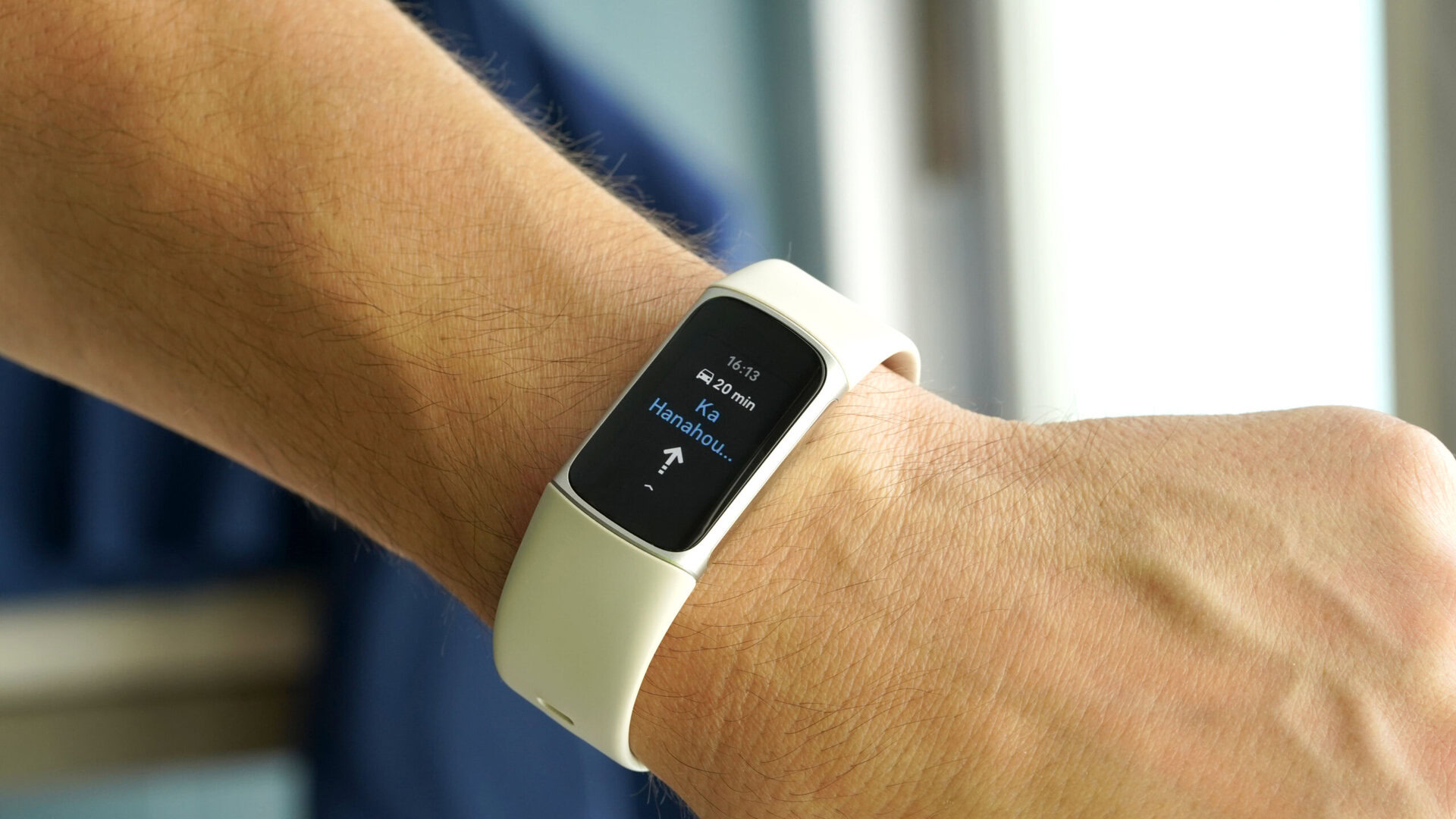Affiliate links on Android Authority may earn us a commission. Learn more.
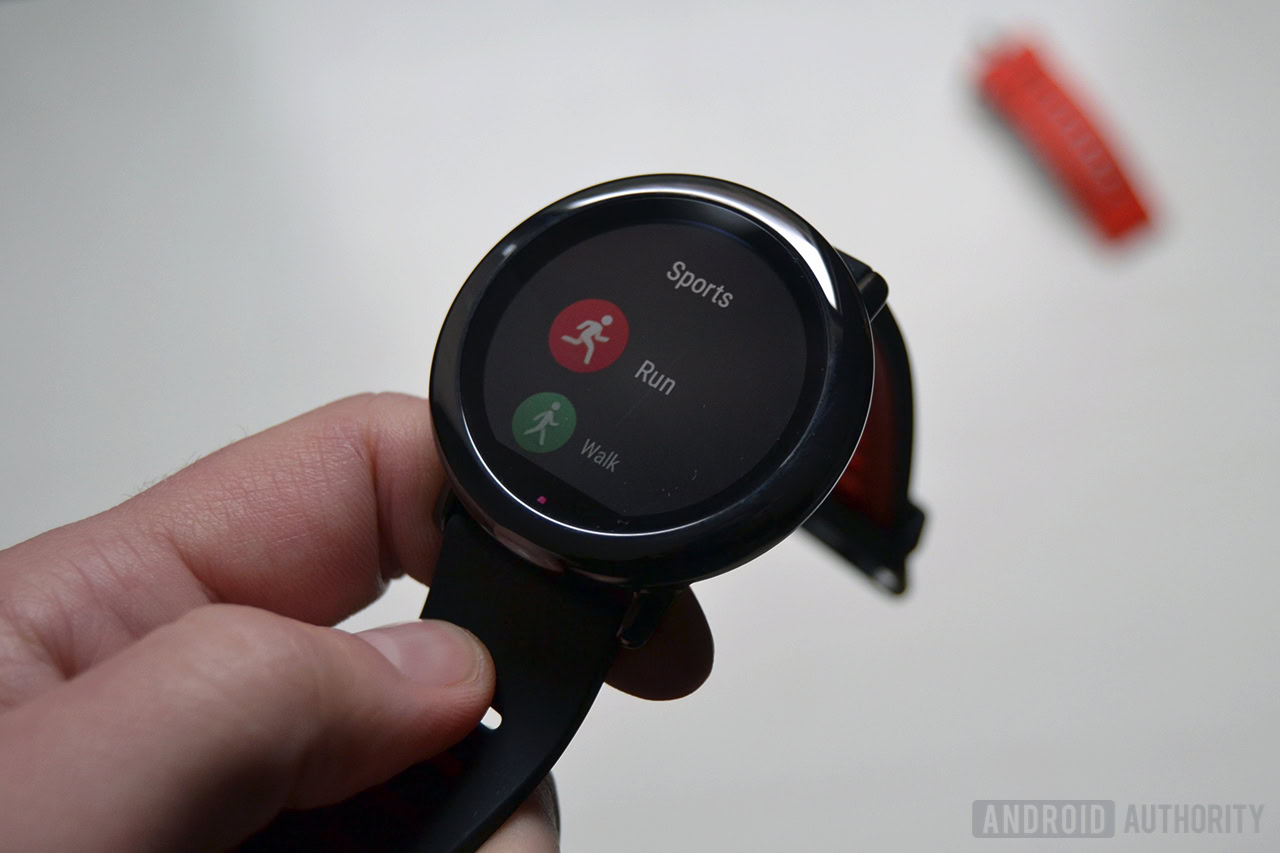
Amazfit PACE
What we like
What we don't like
Our scores
Amazfit PACE
Gone are the days where you need to choose between wearing a fitness tracker or a smartwatch. While it seems many wearables on the market are made to fit squarely in one category or the other, there are a handful of great devices out there that offer the best of both worlds. The Fitbit Blaze, for instance, is a great fitness tracker for those who need a bigger display, while the Moto 360 Sport is a solid smartwatch with some impressive running features built in.
But what if you’re not keen on spending upwards of $200 for one of these devices? Are there any fitness tracker/smartwatch hybrids that don’t break the bank? Enter: the Amazfit PACE.
Back in November 2016, Huami announced that it was bringing its beautiful sub-$200 Amazfit PACE smartwatch to the United States. With a built-in GPS, heart rate sensor and smartphone notification support, could this be the fitness tracker/smartwatch hybrid we’ve been waiting for? Find out, in our full Amazfit PACE review.
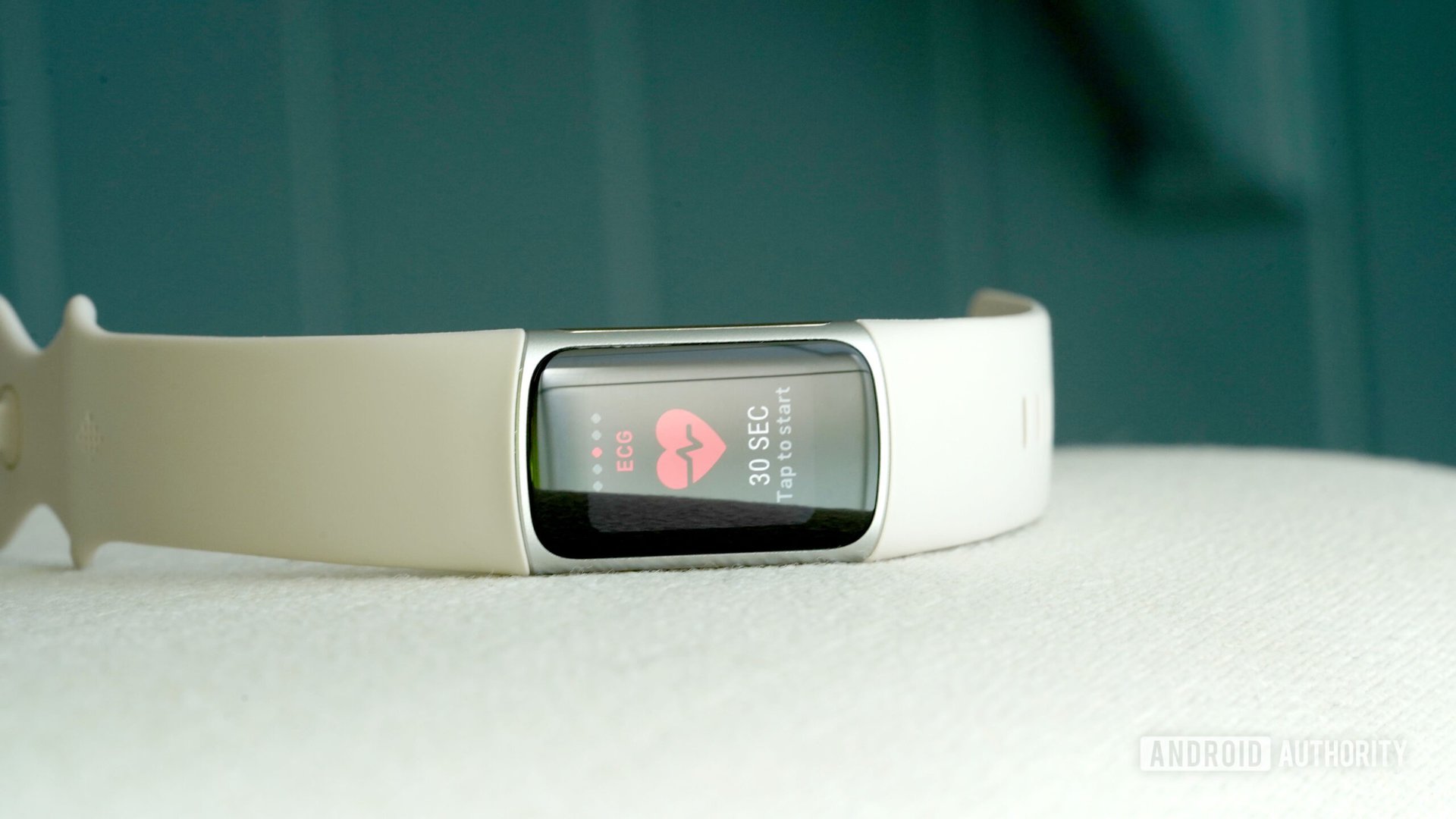
Design
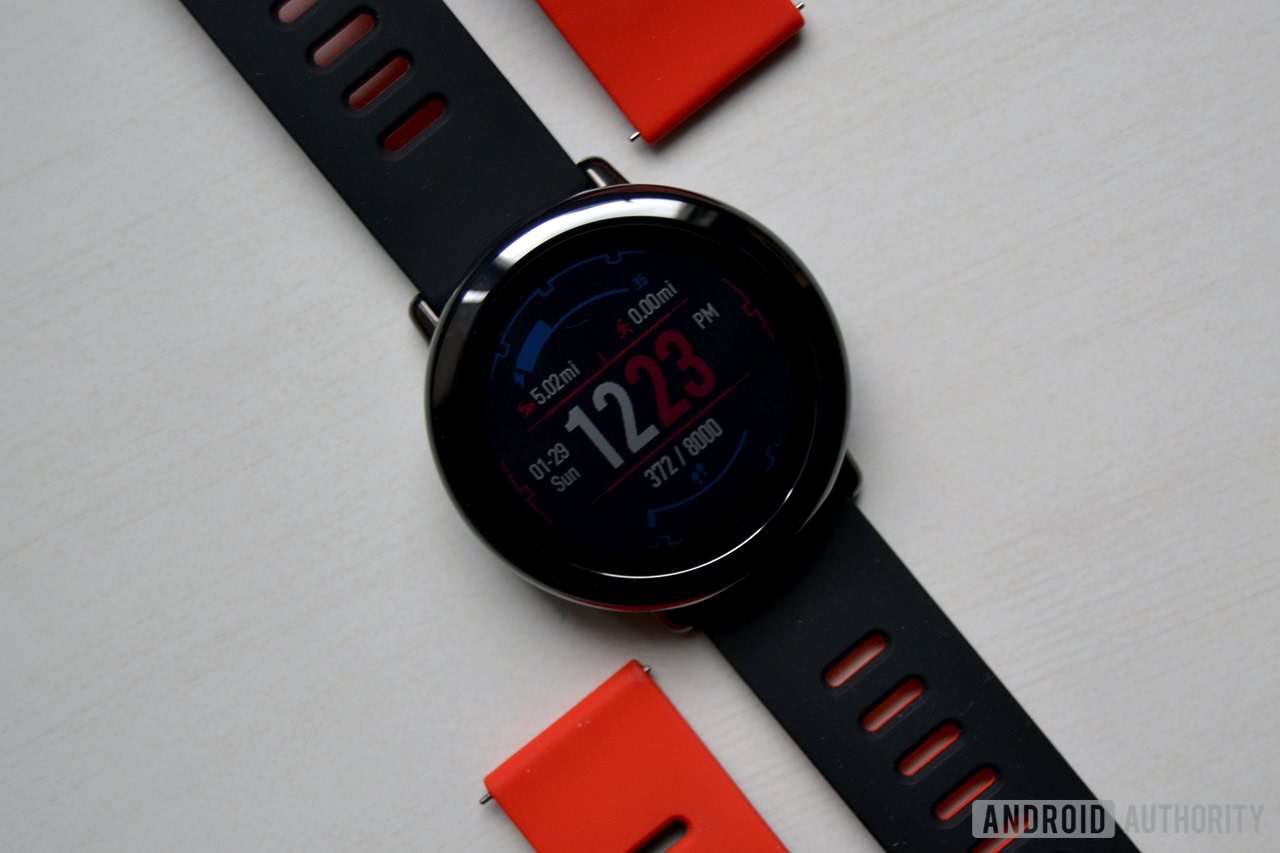
I’m going to come right out and say it – I think the Amazfit PACE is beautiful. It strikes a great balance between sporty and classy that not too many other smartwatches can achieve. That’s mostly thanks to the device’s dark ceramic bezel, which not only looks good, but has proven to be quite durable throughout its testing period.
The watch case also features a small, physical button on the top-right edge, which acts as a home button as well as a way to wake the device. Surprisingly, this small, inconspicuous button is actually one of the watch’s main downfalls. Let me explain.
The touchscreen is disabled until the small physical button is pressed
Although the PACE sports an LCD touchscreen display, the touchscreen part of the screen is disabled until you press the physical button. This is not only inconvenient, but downright annoying at times. When you need to interact with a notification, start a workout, or do anything else on the watch aside from checking the time, you need to remember to press the physical button first. I’ve found this to be particularly inconvenient with notifications. When a text, email or any other type of smartphone alert shows up on the watch, the physical button – which is quite small and difficult to press at times – still needs to be pressed in order to interact with it, even if the display’s backlight is triggered. I’m not sure if I’m just used to the way other smartwatches work, but when I lift my wrist and the backlight turns on, I expect to be able to interact with things right away.
Throughout the PACE’s review period, I have yet to get used to the fact that the touchscreen is disabled by default. Maybe other people will feel differently.
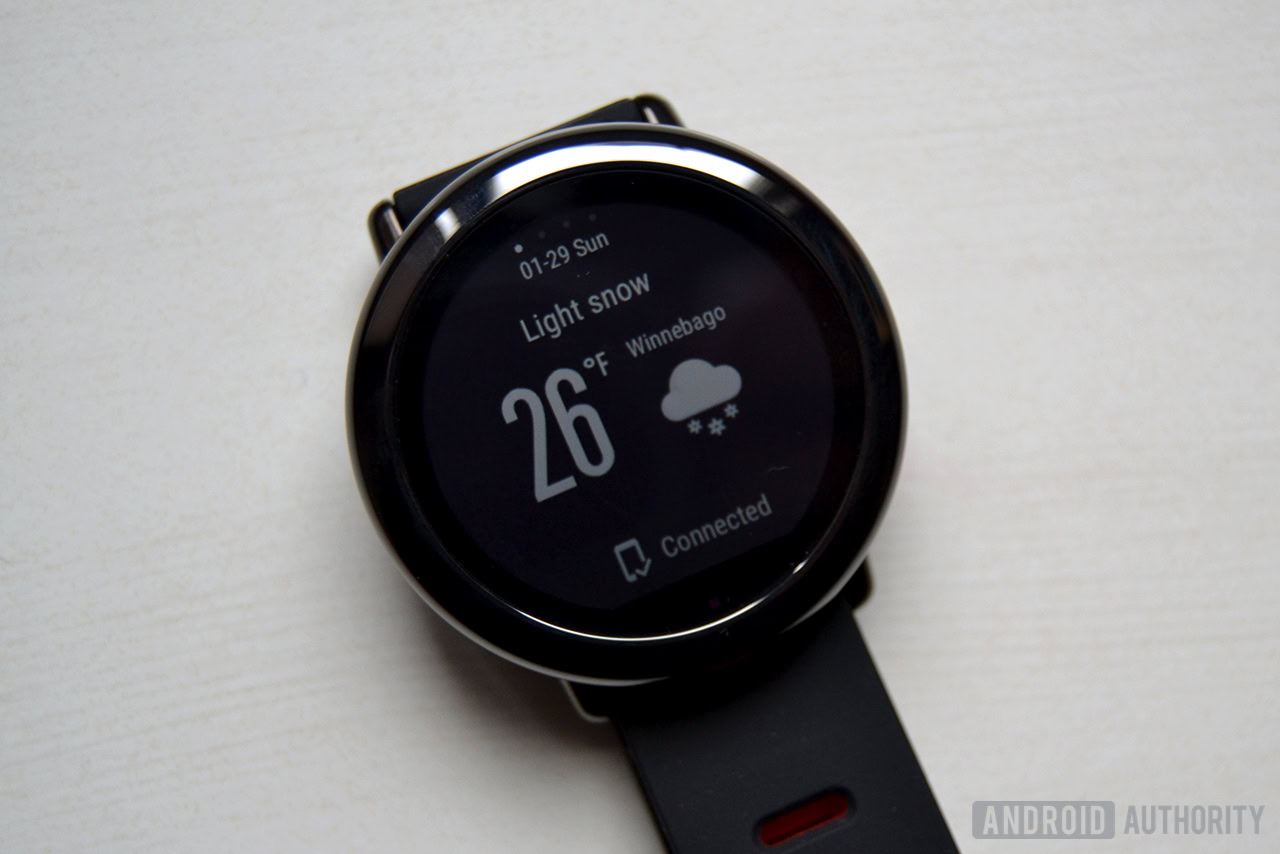
The watch comes with a 1.34-inch transflective color LCD display, with a resolution of 320 x 300. It’s certainly not the most high quality display I’ve ever seen on a smartwatch, but it is very impressive, especially for this price point. It’s visible indoors, even when the backlight is turned off. Plus, this is a transflective display, so the more daylight that hits the screen, the easier it is to read outdoors.
The display is easy to read both indoors and out
On another positive note, the rubber straps that come with the Amazfit PACE are high quality and extremely comfortable. They’re also interchangeable, which means you’ll be able to swap out a rubber strap for just about any standard 22mm watch strap you have lying around.
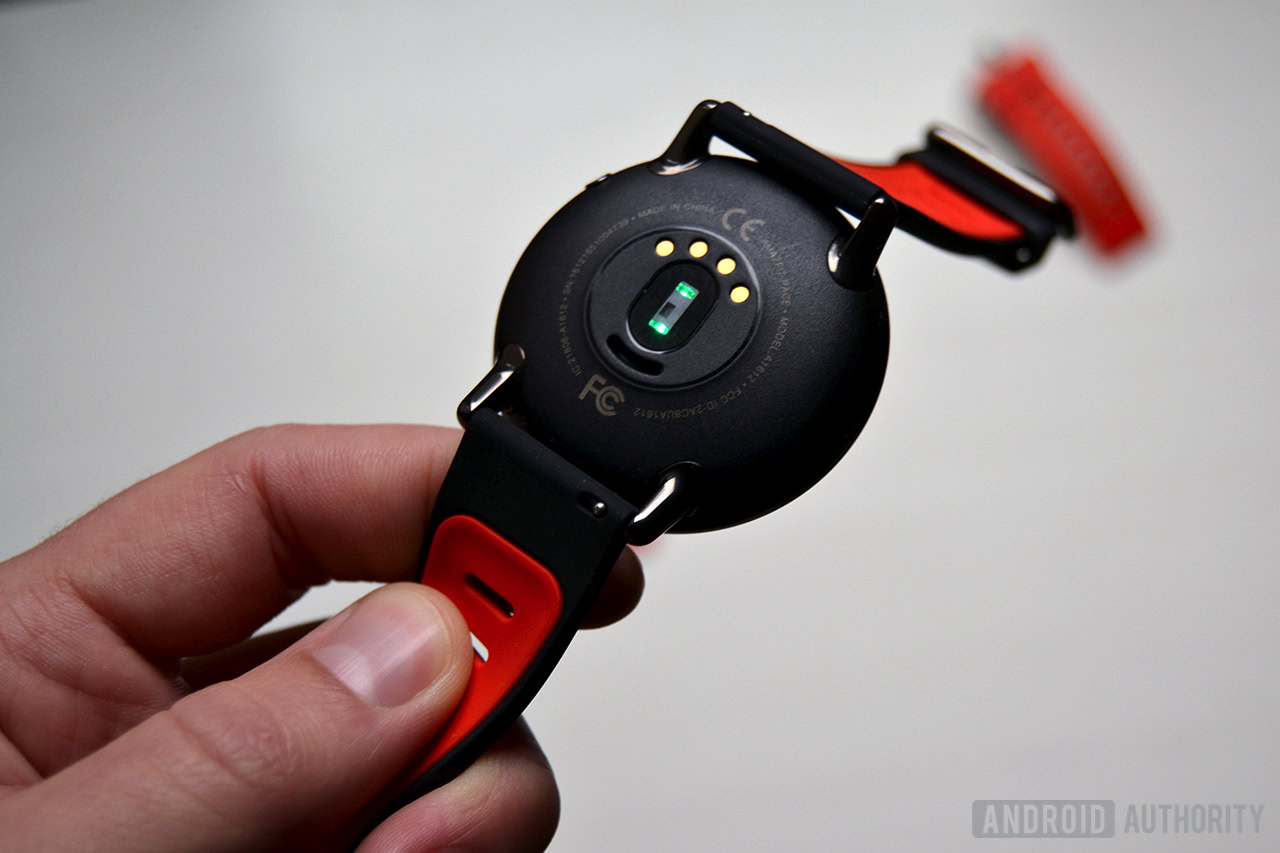
One of the other notable additions to the Amazfit PACE’s design is its IP67 water and dust resistance rating. This means you’ll be able to take it in a pool, though I’m not sure why you’d want to; the PACE only tracks a handful of workouts, none of which include swim tracking.
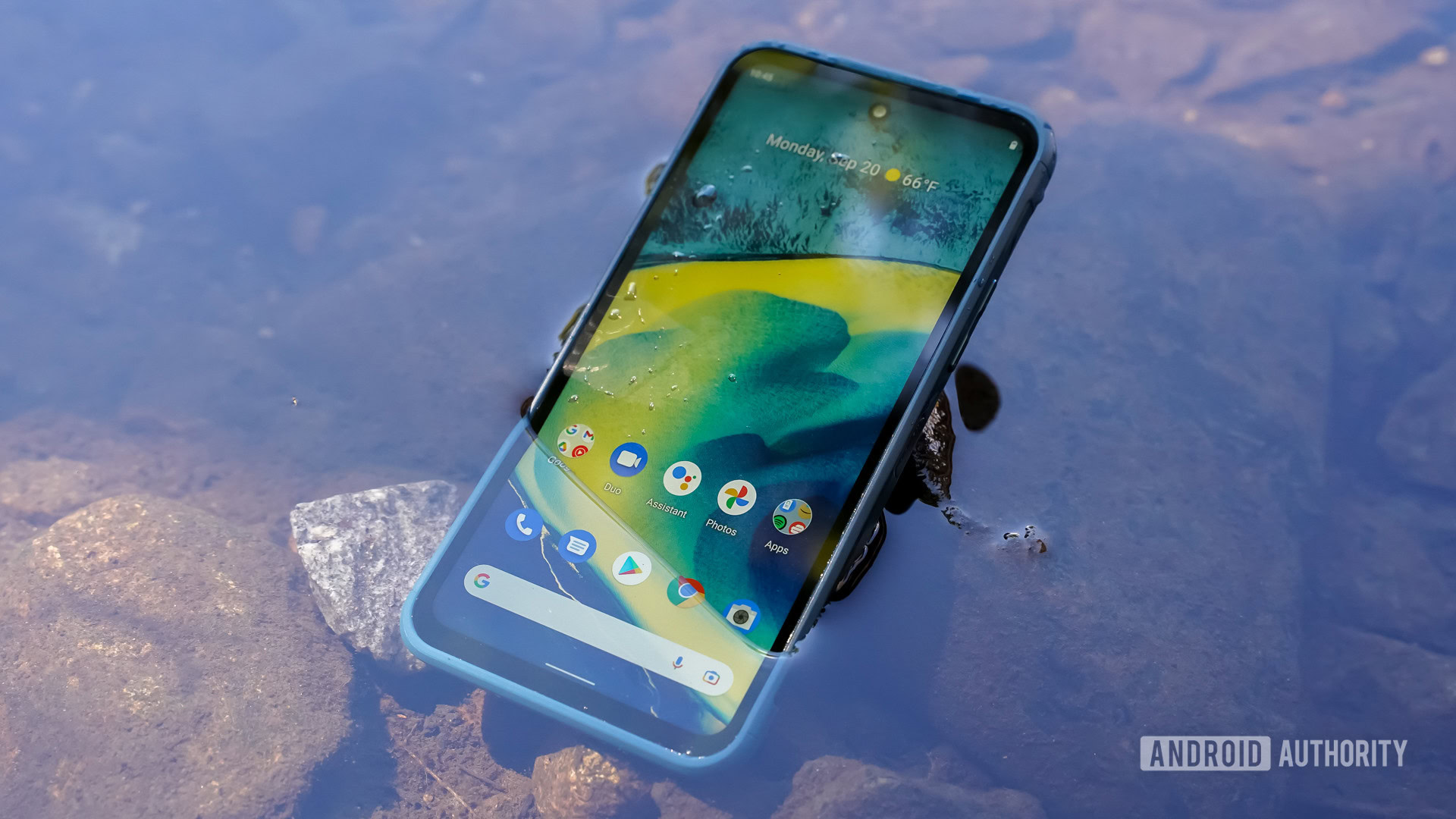
Features and performance
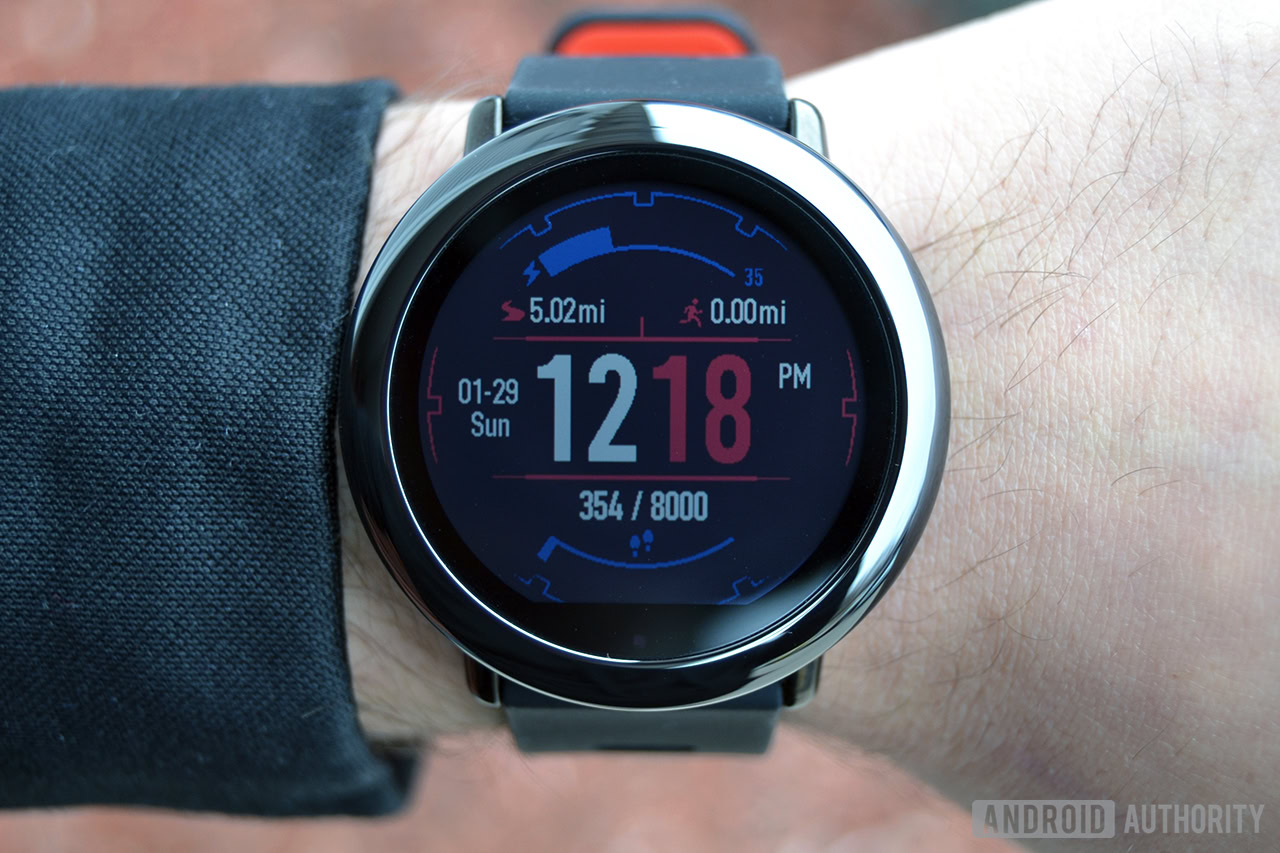
Like most GPS-equipped fitness trackers out there, the Amazfit PACE will track your steps taken, distance traveled, calories burned, resting and active heart rate, and sleep. In it’s current iteration, the device can only track four different activities: run, walk, run indoor and trail run. Amazfit says more activity profiles will be added to the device soon via a software update, but as of right now, these four are all you get.
As far as step tracking is concerned, the Amazfit PACE is pretty much in line with most of the other fitness trackers we’ve tested in recent months. I took the PACE, Garmin’s vívoactive HR and the Fitbit Charge 2 out on a walk for exactly 500 steps, and all three devices finished within 10 steps of each other.
When you’re out on a run, the watch will display quite a bit of information on the workout screen; you can check your total workout time, distance, pace per mile, heart rate, calories burned, speed, cadence, average moving pace, as well as your GPS route. The order in which all of these metrics are displayed makes a lot of sense, and the workout screens are very easy to navigate when you’re out on a run. Just swipe up to get to the next page of metrics, swipe left to get to music controls, or swipe right to pause or stop your workout.
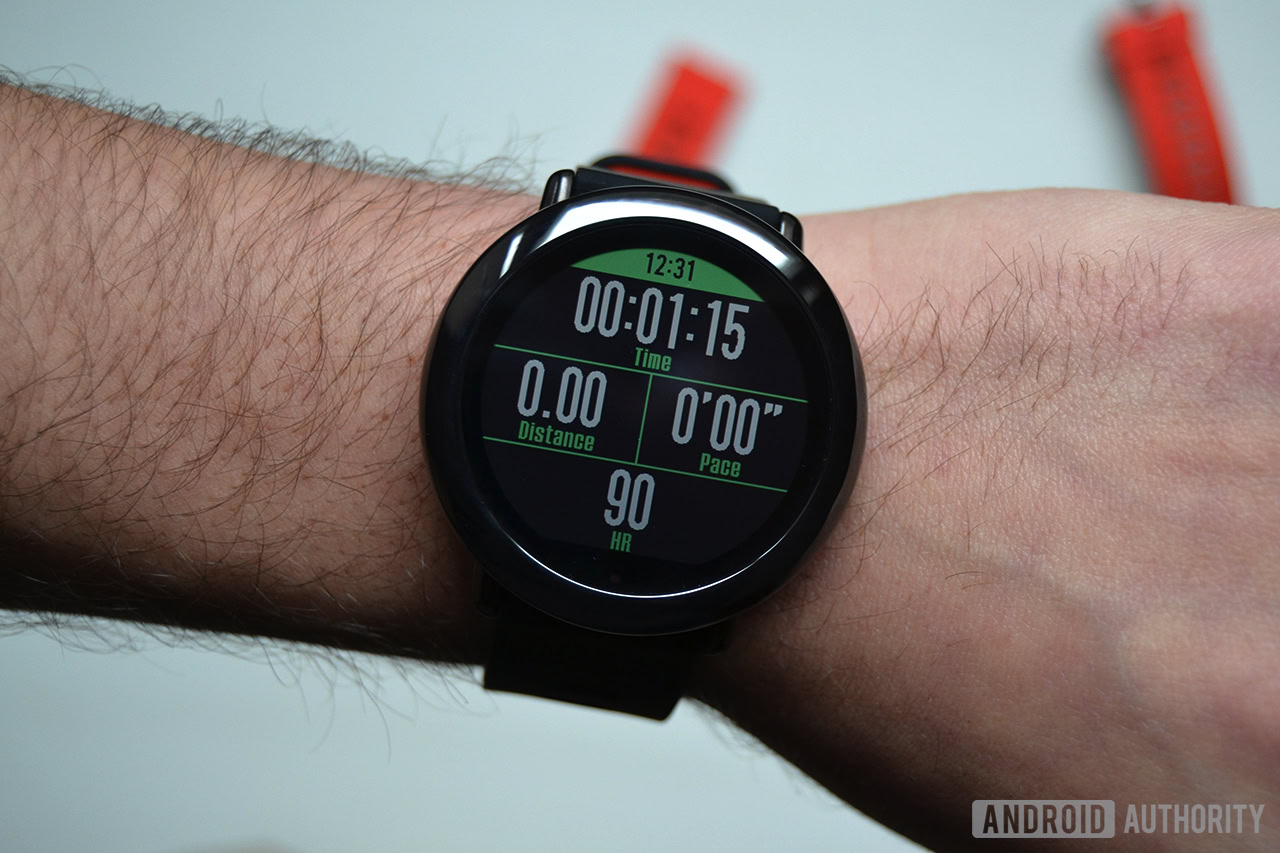
Distance tracking is pretty much spot on, thanks to the PACE's built-in GPS
When you’re in trail running mode, the device will not only track the metrics listed above, but also your altitude, elevation gain/loss, speed, vertical speed and average moving speed. And after you finish with a run, the watch will display your distance traveled, calories burned, average pace per mile, best pace per mile, average moving speed, max speed, average cadence, max cadence and heart rate trends.
It’s worth noting that distance tracking is pretty much spot on, thanks to the PACE’s built-in GPS. For outdoor and trail running, you’ll be able to accurately track your distance and running route with ease. This is because, at the bottom of your workout screen, the watch will display a small map of your running route in case you’re wondering what route you took or where you are.
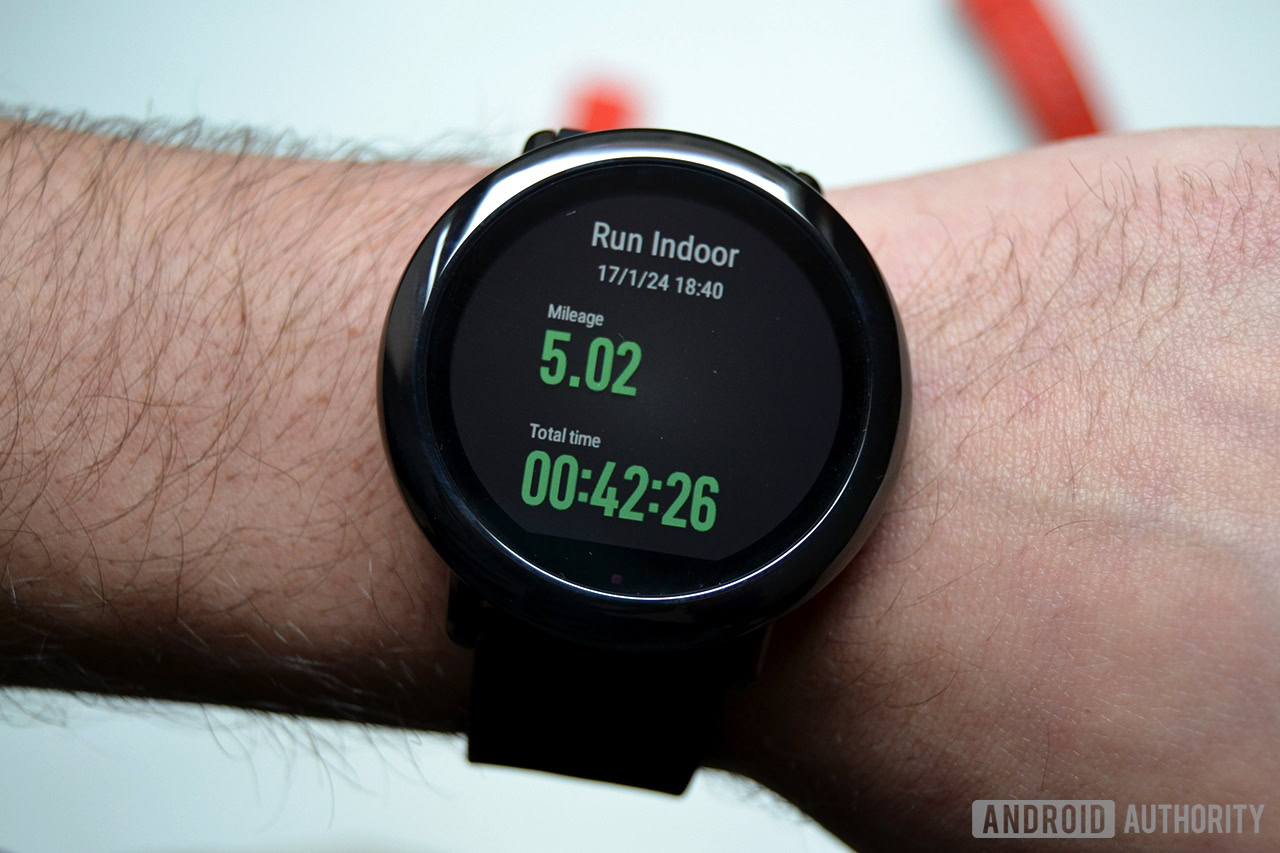
Distance tracking when running indoors is another story, though. On the treadmill at my gym, I ran 5.02 miles in all, though the PACE told me I only went 4.28 miles. Not that this is a huge issue (I had the correct stats on the treadmill, anyway), but it’s still worth addressing. The watch also lets you calibrate your distance after the fact, which is pretty helpful if you’re trying to keep an accurate activity history.
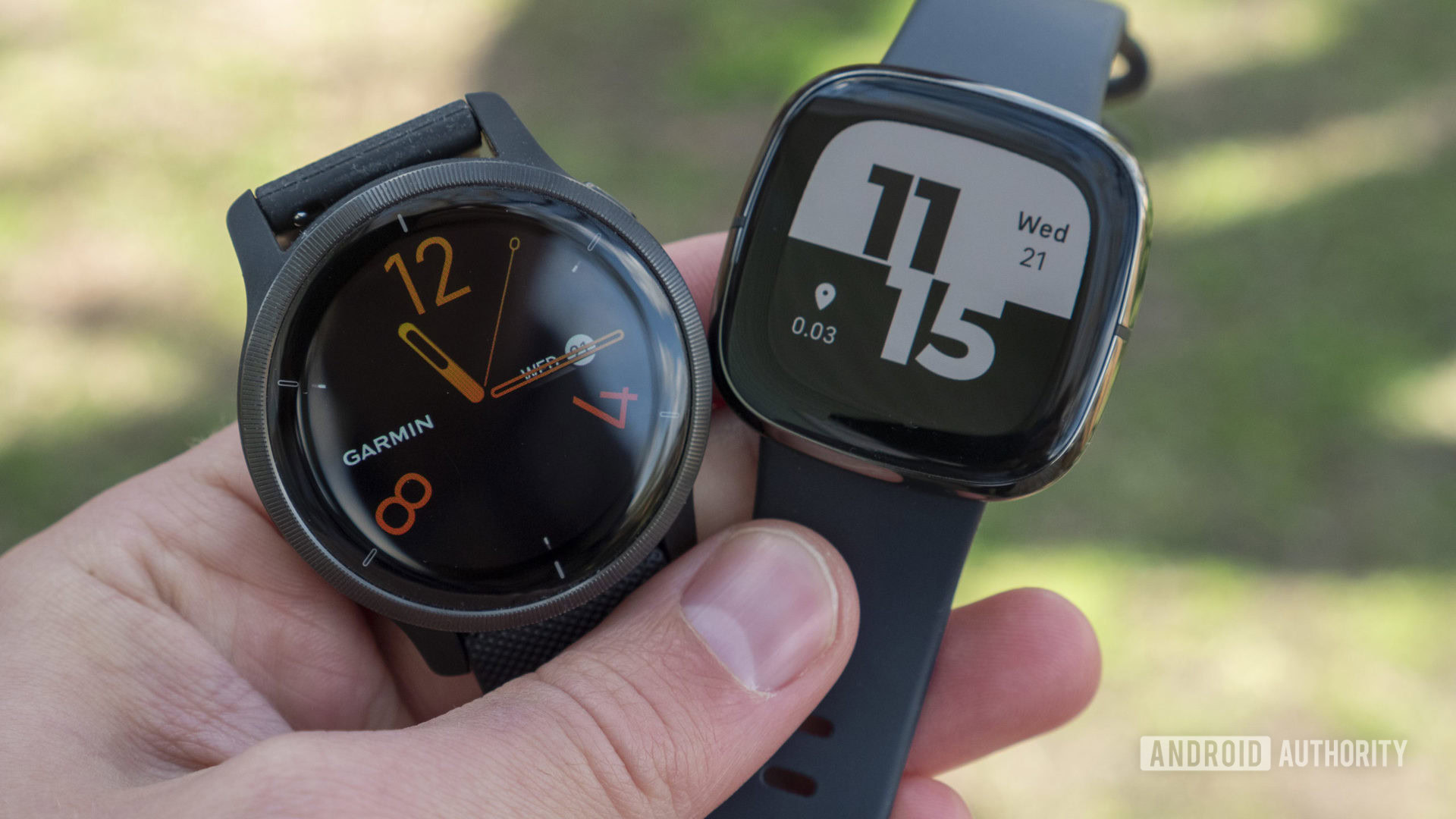
I do need to bring something up here, though, specifically in regards to checking your stats during a run. Because the watch’s touchscreen is disabled until you press the physical button on the side, this can get quite annoying when you’re out on a run and simply want to scroll through to see your activity stats. I know I sound like a broken record here, but this feature really does get in the way all too often.
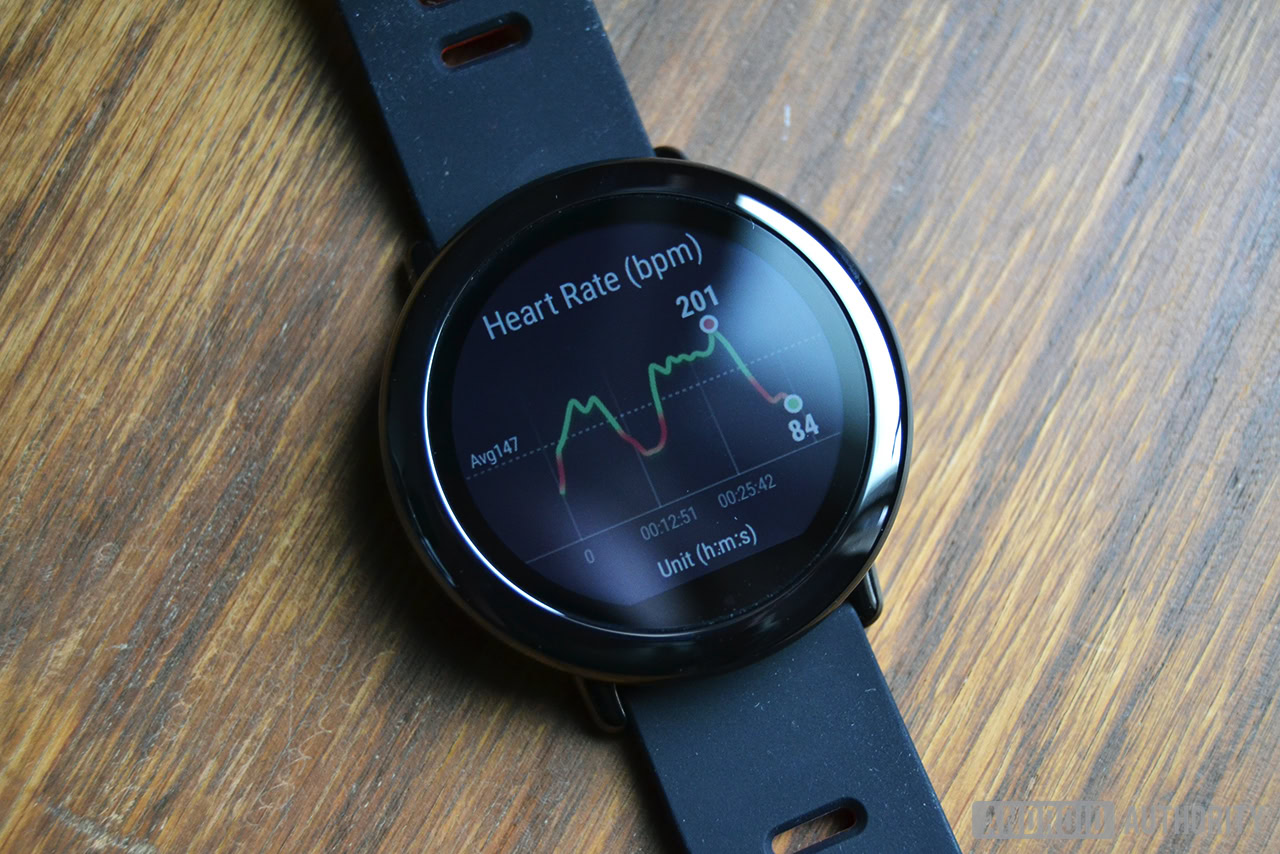
Now let’s talk about the Amazfit PACE’s optical heart rate sensor. It’s accurate when recording resting and active heart rate readings, for the most part, though I have experienced quite a few problems with it recording my peak heart rate numbers about 30bpm too high.
Take a look at the screenshots below, compared to the image attached above of the PACE’s heart rate readings. During this particular workout, I tested the PACE’s heart rate sensor against the Wahoo TICKR X and the Garmin vívoactive HR. As you can see, all three devices recorded most of the highs and lows in the same patterns, though the PACE’s numbers are a bit off. The Amazfit device, in this case, recorded my peak heart rate at 201, while both the TICKR X and vívoactive HR both recorded my max heart rate at 166 or so.
On a more positive note, the watch is quite detailed in the way it presents your heart rate readings. At any point throughout your day, you can swipe over to the heart rate screen and get information on your anaerobic, aerobic, fat burning, non-workout, and sleep heart rate zones. This heart rate section of the watch will also display your maximum and minimum heart rate for the current day, and also your past average heart rate trends.
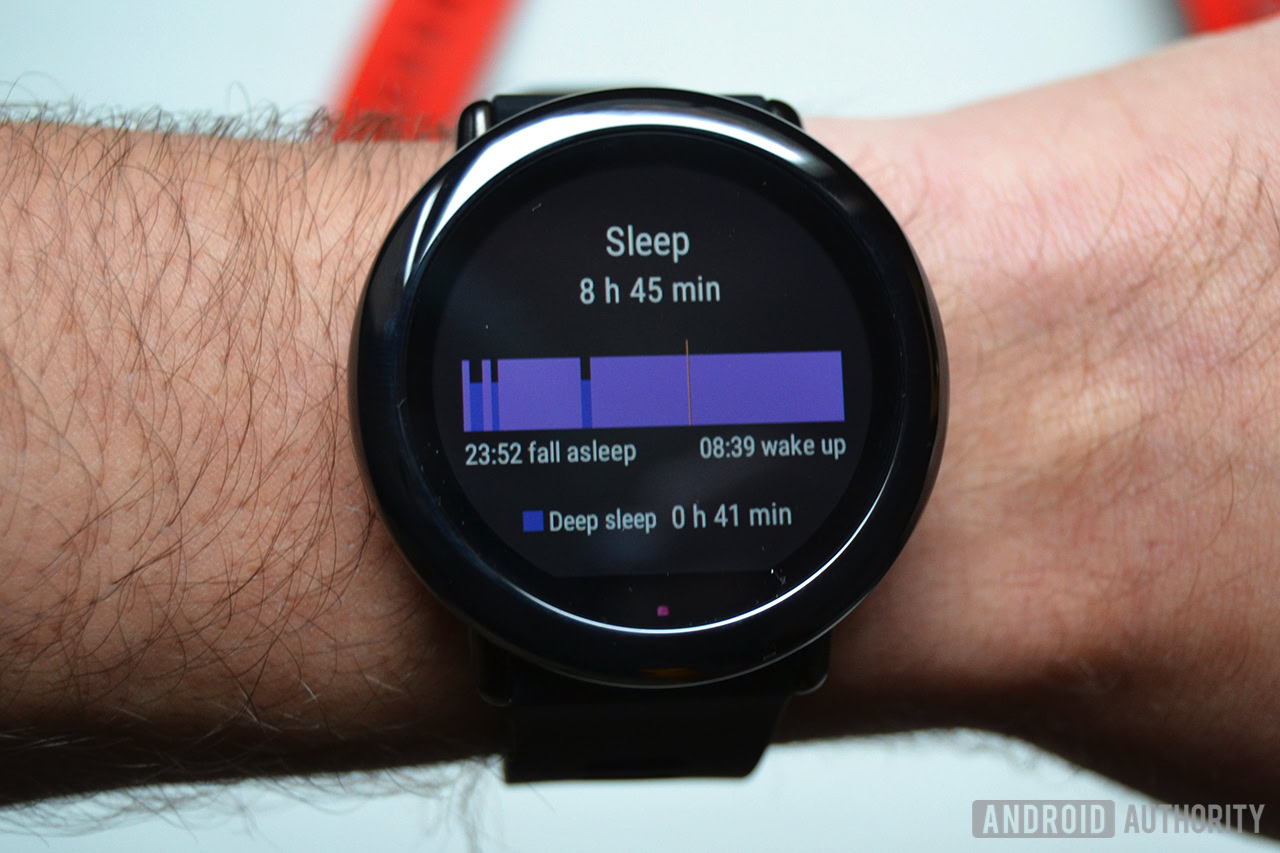
The Amazfit PACE will also automatically track your sleep every night, like most other wrist-mounted trackers out there. Thankfully there’s no need to press a sleep now button to begin sleep tracking; just fall asleep with the tracker on your wrist, and you’ll be able to check out all the data the watch collected in the morning. On the watch itself, you can check out your deep and light sleep, time awake, total sleep time and what time you fell asleep/woke up.
Also read: The best sleep trackers
All of this sleep data may be helpful if you’re just looking back at your previous night’s sleep or your sleep from a few nights ago, but the lack of detailed graphs of your sleep trends overtime is unfortunate. You can select different entries in your sleep history to try to see how you’ve been improving over time, but the watch won’t display any graphs or tables to help you figure it out. All you really get is a small sleep history screen that shows how much deep/light sleep you’ve had over the past few days.
Speaking of sleep tracking, the PACE also has a silent alarm feature, which I’ve been a huge fan of throughout my time with this device. There’s nothing special about how the silent alarms work compared to other fitness trackers; you set your alarm time, how often you’d like it to go off, and your watch will vibrate when that time rolls around. But what makes this such an enjoyable experience is that the Amazfit PACE has one of the best vibration motors I’ve ever come across in an activity tracker. It’s not too jarring, nor is it too soft. It’s a little thing, really, but it really makes wearing this device day in and day out much more enjoyable.
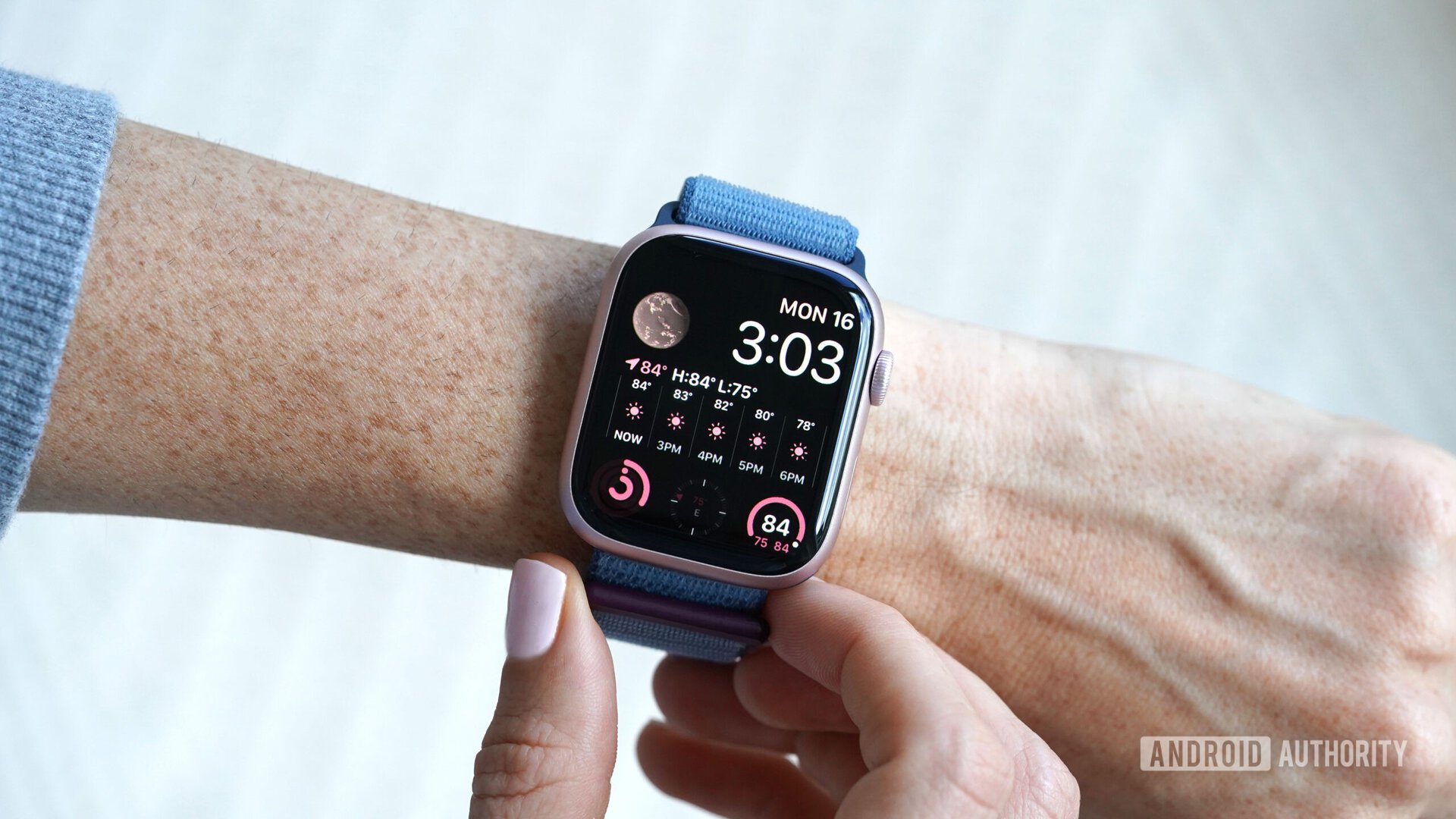
Since this is a smartwatch, after all, you’ll also have the option to receive smartphone notifications on this device. While the implementation of the notifications may be slightly underbaked, the number of notifications you can receive on your device is quite impressive. You can receive virtually any notification you’d like on the PACE, from pretty much any app that’s installed on your phone. Just go into the Notification settings section of the Amazfit Watch app, press the toggle next to the app you’d like to receive notifications from, and that’s it. Easy, right?
Notifications on the watch are kind of a mixed bag, though. Unfortunately this is one of the most underbaked parts of the watch’s software, as I’ve consistently found bugs almost every time I interact with them. While I’ve had no problems receiving notifications from Hangouts, Inbox or Slack, it’s the interaction part that’s buggy. Once you receive a notification, you can swipe right to dismiss it, or swipe left to reply, view the full conversation (only on some apps), or block the app from showing up. Blocking apps works just fine, but tapping the View conversation option causes the launcher to crash, which is never something you want to see. Additionally, as you can see in the first image attached above, the block option has an icon, while the Reply and View conversation options do not, even though they clearly should.
Notifications are one of the most underbaked parts on the watch
One other odd thing – whenever I receive a Slack notification from a coworker, the message arrives in English, but I can also swipe over to see the message in Chinese.
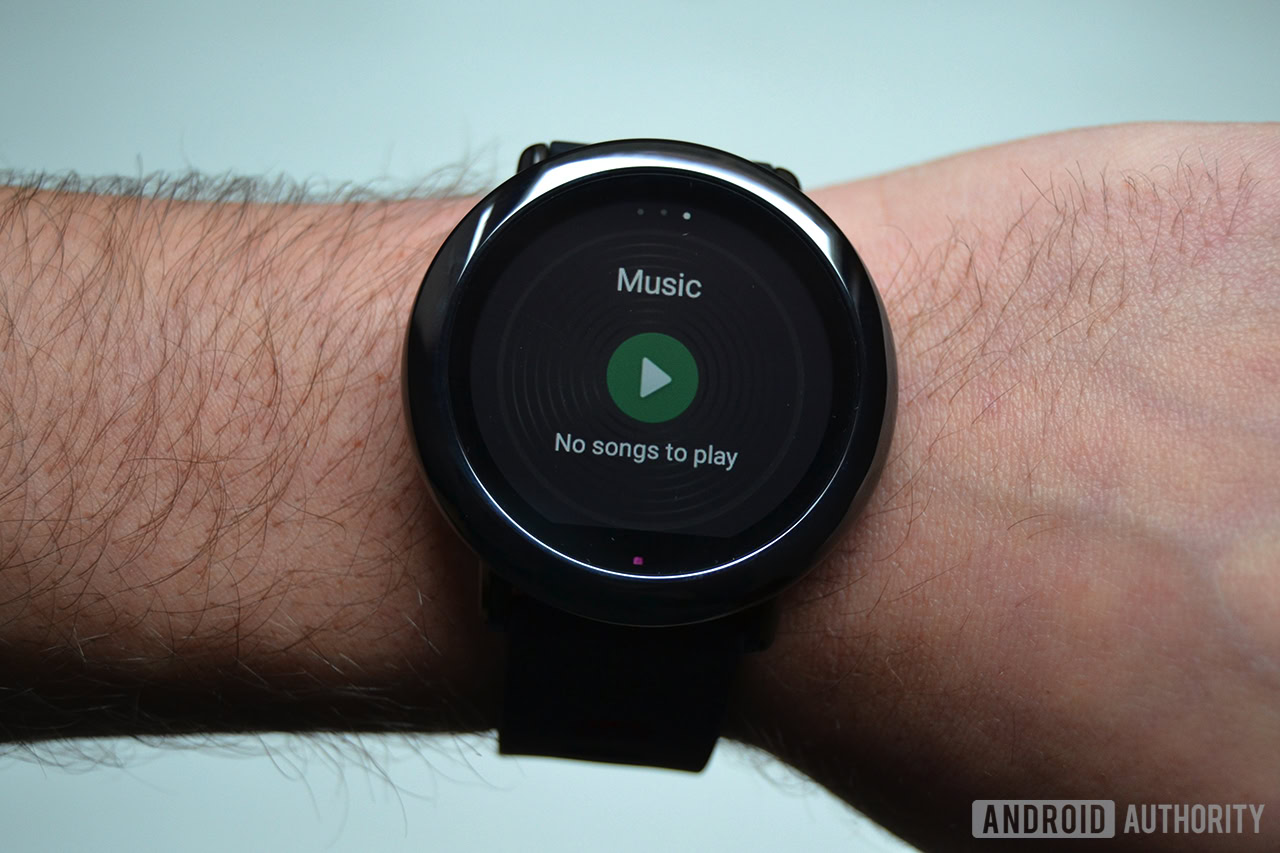
For those of you who like to go running without your smartphone, you’ll be happy to hear the Amazfit PACE comes with 4GB (well, actually closer to 2GB) of on-board storage for loading up music to play when you’re on the go. Just connect your watch to the included charger, plug it into the USB port on your computer, and load up whatever music you’d like. Mac users will need the Android File Transfer program for this to work, just so you know.
I’ve had no problems with music playback so far, and connecting the watch to a pair of Bluetooth earbuds is a breeze. It’s worth noting that the PACE doesn’t offer playlist control (nor does it let you shuffle songs), so you pretty much need to load up your music and listen. I’m sure most runners out there won’t have a problem with this.
Don’t miss: The best Bluetooth earbuds
Much like other fitness trackers out there, the PACE also features move reminders. In case you’re unfamiliar with the feature, the watch will remind you to move every so often if it senses you’ve been sitting for too long. It works pretty well most of the time, and is actually quite useful… especially for someone like me who sits at a desk all day. The move reminders (or Stand up reminders as Amazfit calls them) can be a tad buggy at times, though. Even if I’m up and moving around, I’ll get move reminders from the watch every once in awhile.
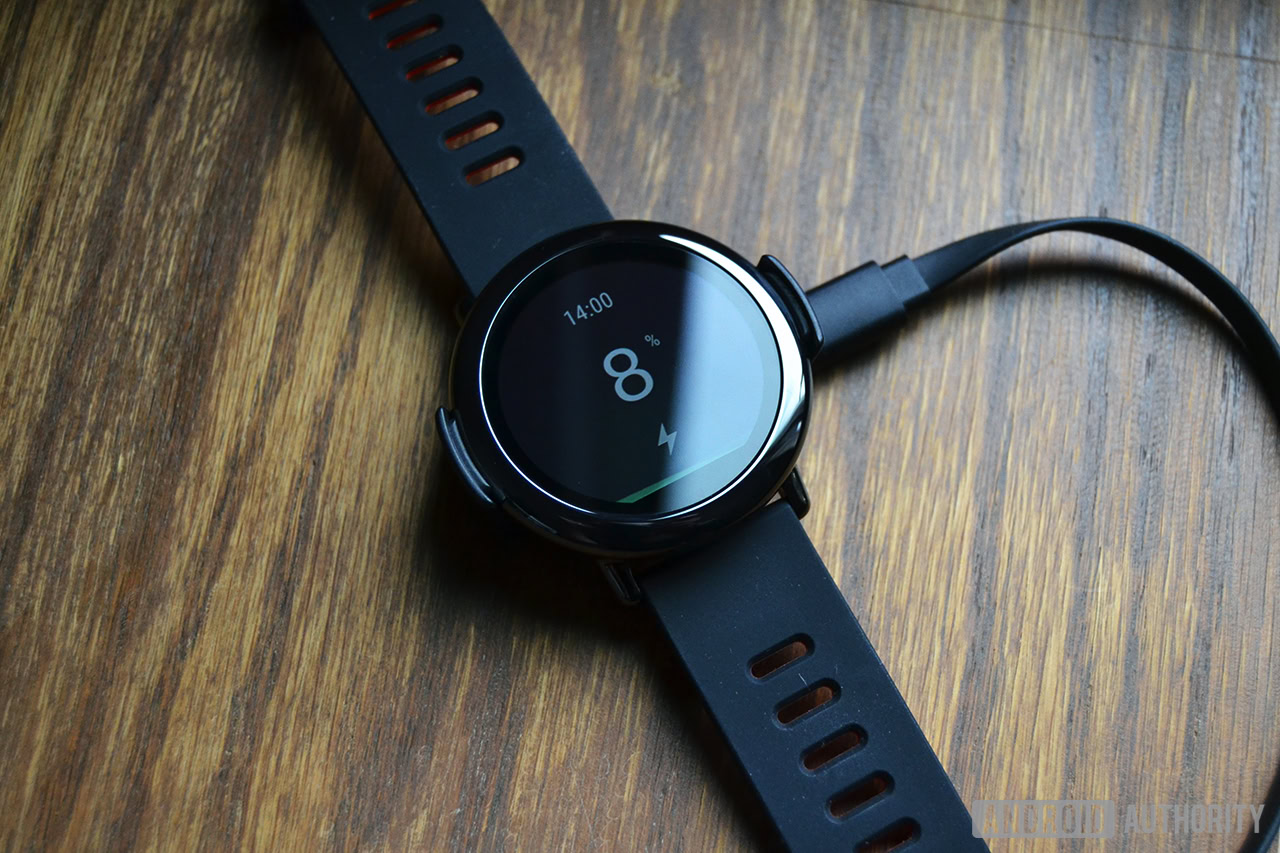
On the battery front, Amazfit says the PACE will be able to last up to 5 days with regular use or 11 days with basic use (no heart rate monitor/GPS use) on a single charge. I’ve found this to be mostly correct throughout my testing period. With moderate to heavy use, the PACE has no problem lasting at least 4 days on a charge, but you can certainly squeeze more out of it if you’re not regularly using the heart rate monitor or GPS.
When you do have to recharge, just place the watch into the included charging cradle, and make sure the pins on the back side of the device are correctly lined up. The cable that comes with the device is pretty long, too, so you shouldn’t have any problems plugging it into your computer or a nearby USB port.
| Huami Amazfit PACE | |
|---|---|
Display | 1.34-inch always-on transflective color LCD touchscreen 320 x 300ppi |
Processor | 1.2GHz |
RAM | 512MB |
Storage | 4GB |
Battery life | Up to 11 days basic use, 5 days regular use 280mAh |
Heart rate monitor | Yes, optical |
GPS | Yes |
Water resistance | Yes, IP67 |
Connectivity | Bluetooth 4.0 Wi-Fi |
Notifications | Call, text, calendar alerts, and more |
Compatibility | Android, iOS |
Weight | 54.5g |
Software
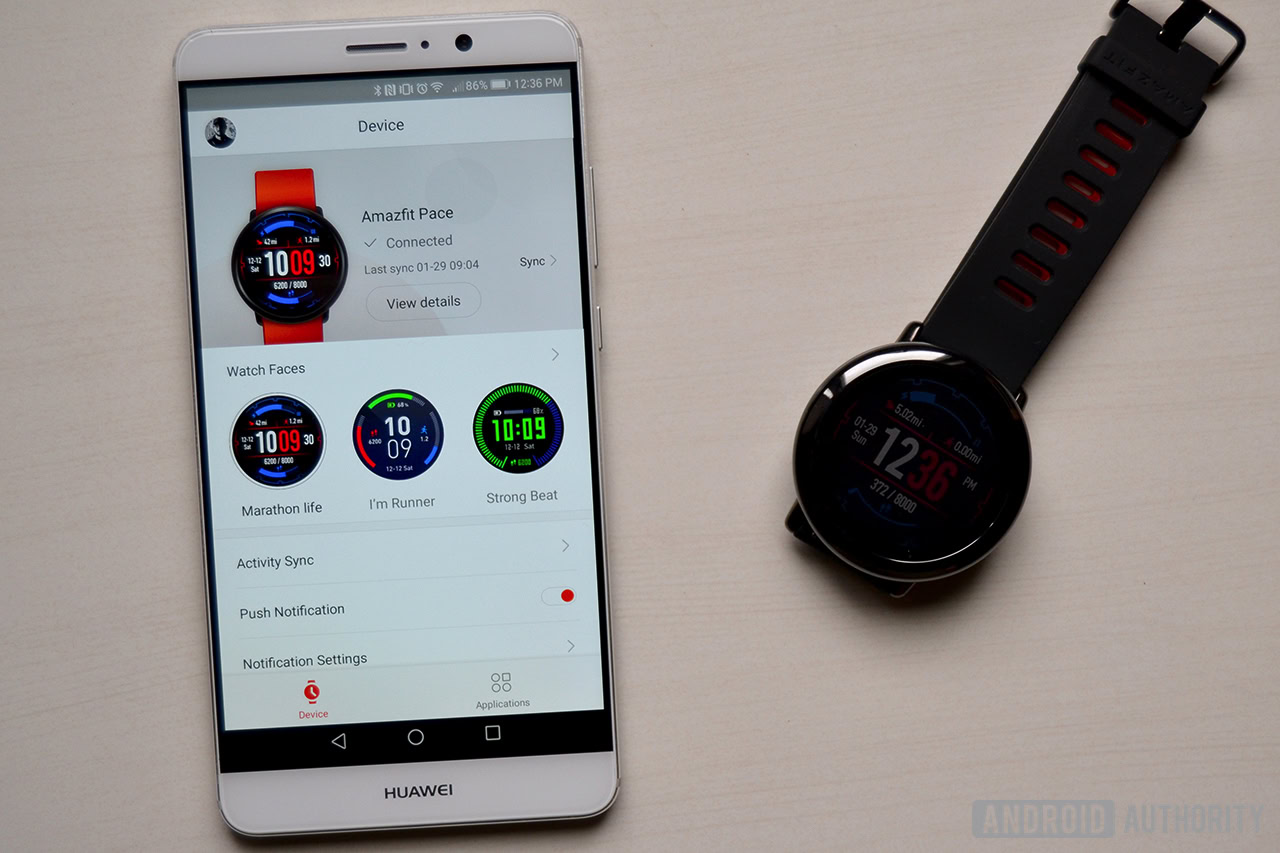
The Amazfit PACE is running a basic form of Android, though it’s not running Android Wear, to be clear. All in all, I’m very happy with the way Amazfit developed this interface, though it is a little heavy on the swiping. You can’t take advantage of voice commands here, so you’ll have to rely on swiping – a lot – to move around the UI.
See also: Best Android Wear watches
From the main watch face screen, you can swipe right to access the activities section, where you can then choose to either start a workout or view your recent activity. Swiping left from the main screen will cycle through different activity stats and applications. This is how you access your daily activity, heart rate, music controls, upcoming alarms, weekly weather forecast, compass and stopwatch. Pulling down from the top of the screen will display the date and the current weather conditions in your area. From here, you can swipe left to get to your battery stats, silent mode toggle, and more settings.
The interface is intuitive, though it can be slow at times
All in all, the interface is intuitive, though it can be slow at times. I don’t think it’s a problem with lag, though. It moreso seems like the animations are just slow to load, which makes quickly navigating around the device’s interface seem like a hassle at times.
There are also quite a few watch faces to choose from (13, to be exact), ranging from sporty to classy. I’m partial to the ‘Marathon life’ watch face, which you can see pictured below.
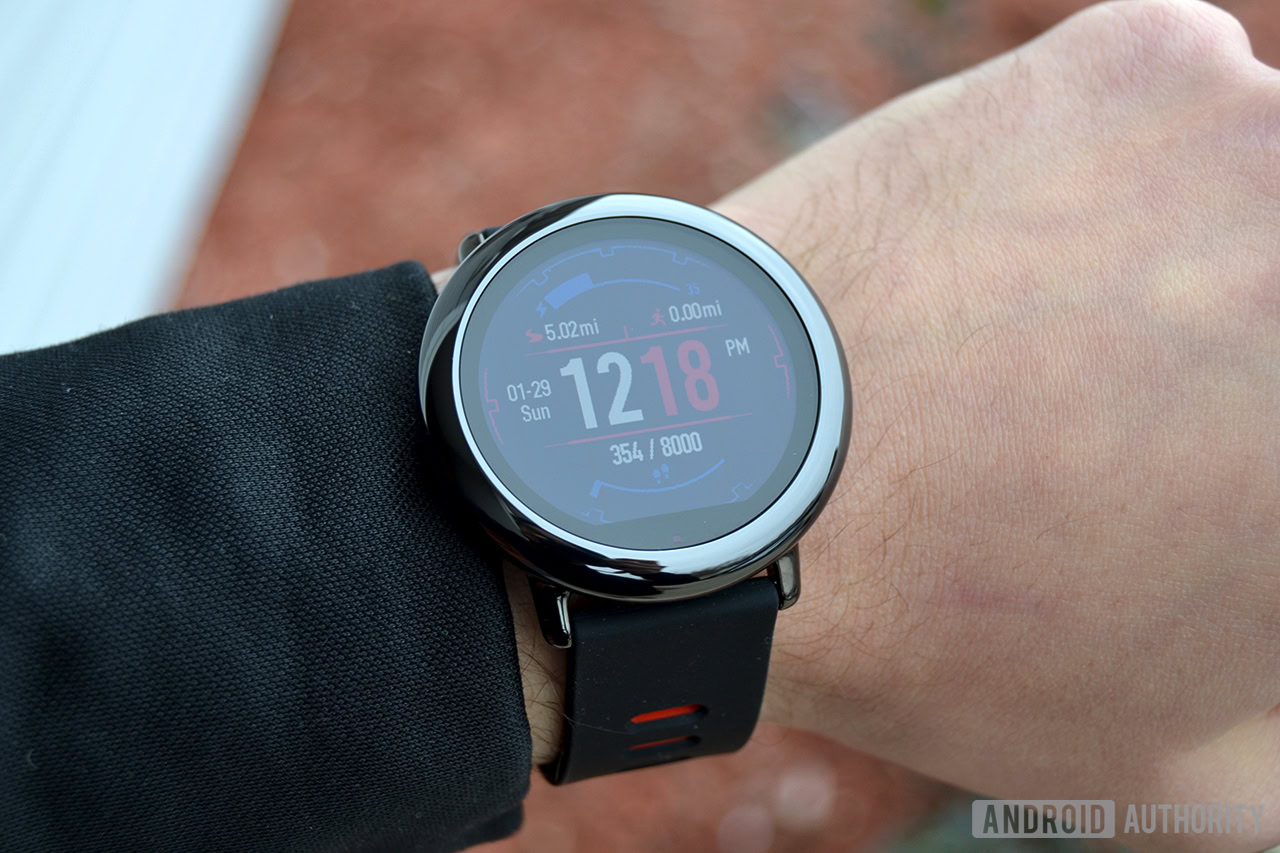
If you’re at all familiar with other wearables on the market, you’d know that many smartwatch makers tend to keep their on-device software on the simple side. Wearable makers tend to offload some of the less-important tasks – like settings menus, alarms, and detailed activity information – onto their smartphone companion apps, since it’s just easier to access these things on a bigger screen.
Unfortunately, this leads me to one of the PACE’s biggest downsides – the watch doesn’t actually have it’s own companion app for activity tracking. This means every workout, heart rate graph, and just about every other activity the device records will have to be viewed on the watch itself. The watch does have support for syncing with Strava, though we obviously would have liked to see it launch with its own companion app for activity tracking.
Also, I’ve had trouble sending my data from the watch to the Strava app, meaning I’ve had to exclusively look at my data on the watch face. I’m sure this will be fixed in a future software update, but it’s still worth bringing up.
The PACE can unfortunately only sync with Strava
While you can only currently view your activity data on the watch itself and in Strava, Amazfit says this will likely change in the future. Unfortunately we have no other details as to when an activity tracking companion app will become available.
Through Strava, you can also send your activity data to Garmin Connect, MyFitnessPal and Google Fit, but this is a pretty cumbersome workaround for something that should be present on the watch by default.
The Amazfit Watch app (pictured above) is used for syncing and pairing the device with your smartphone, and it’s also the app you’ll use to change watch faces and manage notifications. This app also allows you to pair your account with Strava. It’s by no means an activity tracking app, though.
Gallery
Should you buy it?
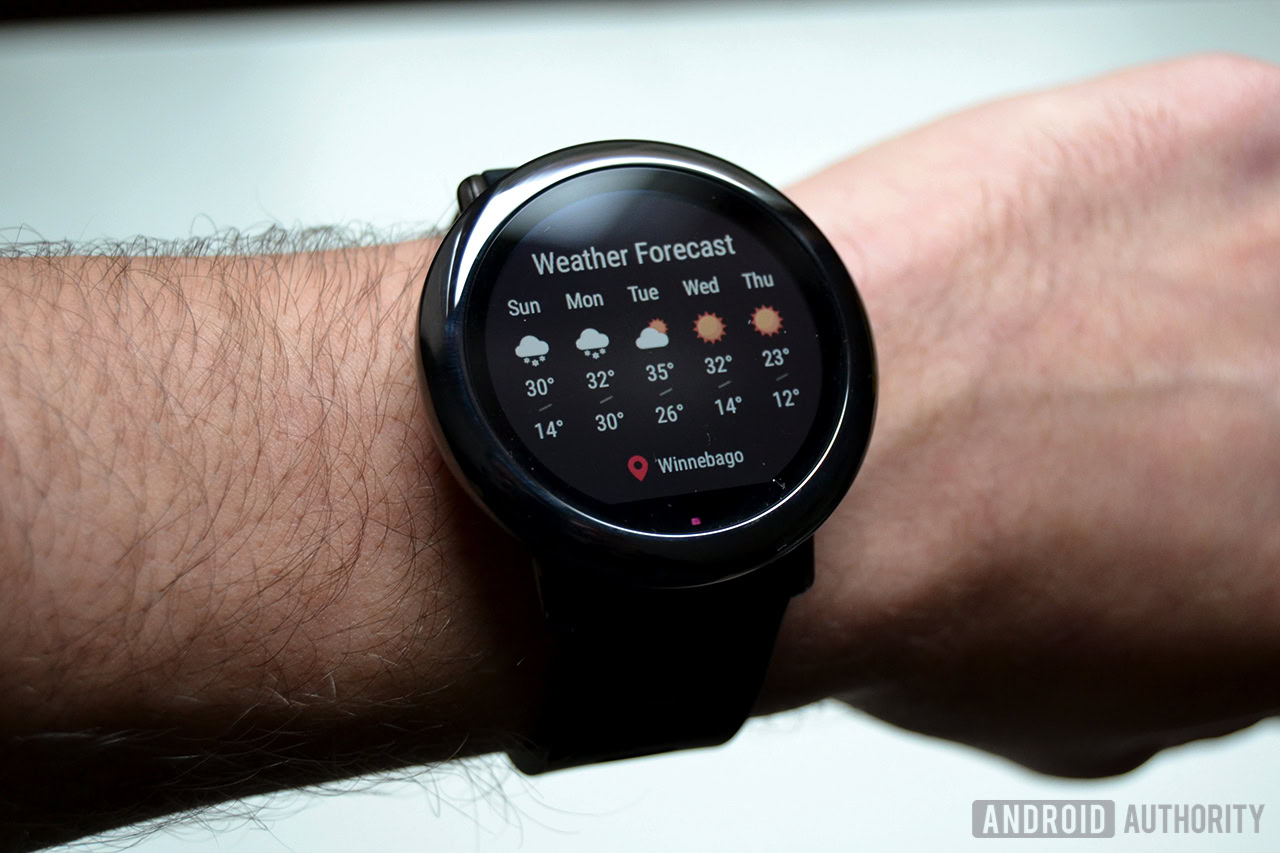
The Amazfit PACE is available for $159.99 from the official Amazfit website, though it’s currently selling on Amazon for just under $120. So the question is, is this device right for you?
As I’ve alluded to throughout the majority of this review, the Amazfit PACE has a few notable software issues. The level of polish and refinement that I expected to see in this device’s software simply doesn’t match the beautiful hardware. That might be okay for some people, and it’s certainly hard to argue with the sub-$200 price point… especially considering all the features that are packed into this device.
But if you’re interested in this device, you should definitely take a look at the competition before making your decision. First of all, since the number of activities the PACE can track is pretty limited at the moment, you might want to pass if you’re not a runner. And if you are a runner, you might want to check out the Moto 360 Sport. It’s available on Amazon for around $125, and it’s a truly great smartwatch. Plus, it also has an on-board GPS, heart rate monitor, and is slated to get the big Android Wear 2.0 update sometime soon.
That’s if you need a smartwatch, though. If you’re in need of a powerful fitness tracker with a GPS and heart rate monitor that supports smartphone notifications (and has a powerful companion app), you can’t go wrong with the Garmin vívosmart HR+. This device is available from Garmin’s website for $199.99, if you don’t mind paying a little extra.
What I’m trying to say is, there are much more powerful fitness trackers on the market, and there are better smartwatches on the market, too. The PACE is a solid first effort from Amazfit, but for me, the negatives outweigh the positives. The lack of a dedicated companion app and the buggy software outshine the beautiful build quality and awesome battery life. With that said, if those caveats don’t matter much to you, the Amazfit PACE might be a good option.
What do you think of the Amazfit PACE? Be sure to speak up in the comment section below!
